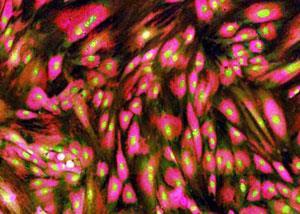Tiny crystals of mineral cement make perfect home for stem cells
A nanocrystalline cement could help bone grafts to heal more quickly, Chinese scientists have claimed.
The amorphous calcium phosphate (ACP) cement used in bone and dental surgery has always been thought to make bones repair faster than more solid alternatives. But now researchers from Zhejiang University, Hangzhou, have found that the stem cells that help the healing process actually grow more easily on tiny crystals of hydroxyapatite (HAP, Ca10(PO4)6(OH)2), an excellent inorganic model of human bone and tooth enamel.

’Previously, scientists have paid too much attention to the chemical composition of the ceramics,’ said Ruikang Tang, who led the research team. Their study focussed instead on the crystal size effects by keeping the size of the hydroxyapatite particles very close to 20nm.
Their in vitro experiments showed that crystalline HAP showed better healing potential than the supposedly superior cement. Crystalline hydroxyapatite in the size range 20-40nm is a basic building block for biological bone and enamel, explained Tang, so ’ideal biomedical materials should have the same features to improve tissue repair.’ The team now plan to test their nano-cement in laboratory animals.
Lee Buttery, a tissue engineering researcher at Nottingham University School of Pharmacy, agrees that particle size has been overlooked. ’In the body the bone marrow stem cells clearly respond to nanoscale features which stimulate growth,’ he said. ’We’re only now starting to look at the "smaller" picture.’
Jonathan Edwards
References
Q Hu et al, J. Mater. Chem., 2007, DOI 10.1039/b710936a






No comments yet